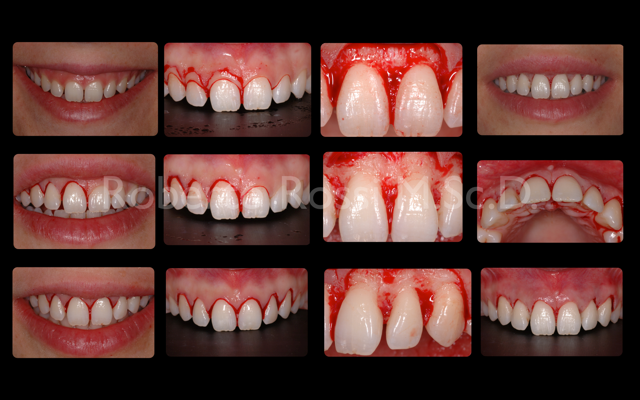Home/Articles
/ Periodontology /
Reena’s Notes: 12 Key Points on the Assessment & Treatment of a “Gummy Smile” with Dr Roberto Rossi
March 9, 2015

- The aesthetics of a smile are dependent on the teeth, gingivae and lips.
a) The teeth should be of a shade appropriate to the age of the individual, the position and shape of the teeth are also important.
b) The gingivae should be healthy, symmetrical and in harmony with the dentition.
c) The lips define the aesethic zone and one can have a high/medium/low lip line. The gingival line should follow the contour of the upper teeth and the incisal margin of the teeth should follow the form of the lower lip. - A normal gingival display between the inferior border of the lip and the gingival margin of the maxillary teeth during a ‘posed smile’ is 1-2 mm (Vig & Brundo 1978). An excessive gingival-to-lip distance of 4 mm or more is classified as unattractive by lay people and general dentists (Kokich et al 1999).
- The aetiological factors of excessive gingival display or a “gummy smile” include: altered passive eruption, vertical maxillary excess/protrusion, short upper lip, hypermobile upper lip, and compensatory eruption of maxillary teeth.
- Altered passive eruption is the failure of the gingival tissue to adequately recede to the proper level relative to the CEJ due to the disruption in the development and eruptive patterns of the dentogingival unit, resulting in a short clinical crown. The average clinical crown height of an adult maxillary incisor is 9-12 mm (10.6 mm in males, 9.5 mm in females).
- Coslet et al (1977) have described have divided altered passive eruption into:
Type I – Gingival margin incisal to the CEJ, where there is noticeably wider gingival dimension from the margin to the mucogingival junction.
Type II – Gingival margin located at the CEJ – dimension from the gingival margin to the mucogingival junction, which appears to be within the normal mean width.
Subtype A – The alveolar crest-CEJ distance is approximately 1.5 mm. This allows for normal attachment of the gingival fibres into the cementum.
Subtype B – The alveolar crest is at the level of the CEJ. - In altered passive eruption, the gingivae are often inflamed due to the lack of oxygen caused by he improper position.
- The prevalence of altered passive eruption – 7% of young adult males, 14% of young adult females (Diamon 1996).
- A thorough assessment of these cases is necessary to allow appropriate treatment planning.
a) A full facial as well as rest and dynamic smile analysis is required.
b) Photographs should include rest, natural and forced smile positions. The number of teeth that show on smiling will determine the teeth that need to be treated.
c) A Chu probe (Chu 2008) is a biometric gauge that helps assess the tooth dimensions.
d) Radiographs taken using a standard paralleling technique should be taken to determine the level and anatomy of the alveolar crest and this will also allow measurement of the anatomical crown. CBCT scans may be helpful is specific cases.
e) If prosthetic work will be required, a mock-up and pre-visualisation will be necessary to evaluate the smile before moving onto the definitive restorations. The mock up will be used as a template for surgery i.e. to determine how much resection is required. - It is important to make the correct diagnosis, as this will determine the treatment required. The overall surgical procedure required is crown lengthening. Type 1 will require a gingivectomy. Subtype B will require a flap with osseous resection to re-create the biologic width.
- When completing the crown lengthening surgery start off with one side and then using this split-mouth design, perform the surgery on the contralateral side. Usually a gingivectomy is completed, a flap is raised to assess the bony anatomy, osseous resection is performed where necessary to establish the biologic width as well as create a positive osseous architecture and the flap is thereafter sutured in the new position.
- Using the STA machine (computerised device that delivers anaesthesia slowly) with a palatal approach can allow for smile analysis during/immediately after surgery without worrying about the temporary paralysis of the muscles caused by conventional buccal infiltrations.
- Sometimes both the upper and lower arch are involved and each may be of a different subtype. If orthodontics is required this must be completed first. The restorative phase will follow the surgical treatment. Long-term maintenance of these cases is imperative.



